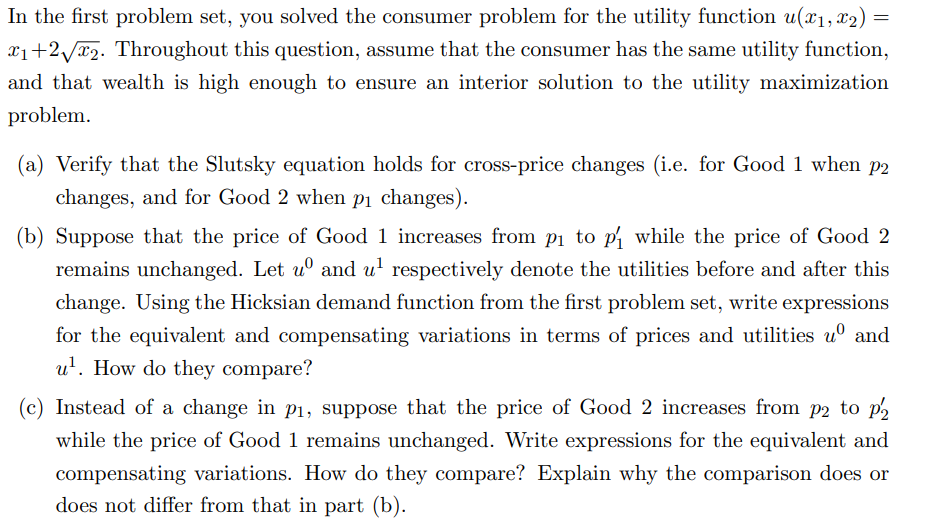In the first problem set, you solved the consumer problem for the utility function u(x1, x₂) = ₁+2√2. Throughout this question, assume that the consumer has the same utility function, and that wealth is high enough to ensure an interior solution to the utility maximization problem. (a) Verify that the Slutsky equation holds for cross-price changes (i.e. for Good 1 when p2 changes, and for Good 2 when p₁ changes). (b) Suppose that the price of Good 1 increases from p₁ to p₁ while the price of Good 2 remains unchanged. Let uº and u¹ respectively denote the utilities before and after this change. Using the Hicksian demand function from the first problem set, write expressions for the equivalent and compensating variations in terms of prices and utilities uº and u¹. How do they compare? (c) Instead of a change in p₁, suppose that the price of Good 2 increases from p2 to p/2 while the price of Good 1 remains unchanged. Write expressions for the equivalent and compensating variations. How do they compare? Explain why the comparison does or does not differ from that in part (b).
In the first problem set, you solved the consumer problem for the utility function u(x1, x₂) = ₁+2√2. Throughout this question, assume that the consumer has the same utility function, and that wealth is high enough to ensure an interior solution to the utility maximization problem. (a) Verify that the Slutsky equation holds for cross-price changes (i.e. for Good 1 when p2 changes, and for Good 2 when p₁ changes). (b) Suppose that the price of Good 1 increases from p₁ to p₁ while the price of Good 2 remains unchanged. Let uº and u¹ respectively denote the utilities before and after this change. Using the Hicksian demand function from the first problem set, write expressions for the equivalent and compensating variations in terms of prices and utilities uº and u¹. How do they compare? (c) Instead of a change in p₁, suppose that the price of Good 2 increases from p2 to p/2 while the price of Good 1 remains unchanged. Write expressions for the equivalent and compensating variations. How do they compare? Explain why the comparison does or does not differ from that in part (b).
Chapter7: Uncertainty
Section: Chapter Questions
Problem 7.11P
Related questions
Question

Transcribed Image Text:In the first problem set, you solved the consumer problem for the utility function u(x₁, x₂) =
₁+2√2. Throughout this question, assume that the consumer has the same utility function,
and that wealth is high enough to ensure an interior solution to the utility maximization
problem.
(a) Verify that the Slutsky equation holds for cross-price changes (i.e. for Good 1 when p2
changes, and for Good 2 when p₁ changes).
(b) Suppose that the price of Good 1 increases from p₁ to p₁ while the price of Good 2
remains unchanged. Let u and u¹ respectively denote the utilities before and after this
change. Using the Hicksian demand function from the first problem set, write expressions
for the equivalent and compensating variations in terms of prices and utilities uº and
u¹. How do they compare?
(c) Instead of a change in p₁, suppose that the price of Good 2 increases from p2 to p2
while the price of Good 1 remains unchanged. Write expressions for the equivalent and
compensating variations. How do they compare? Explain why the comparison does or
does not differ from that in part (b).
Expert Solution
This question has been solved!
Explore an expertly crafted, step-by-step solution for a thorough understanding of key concepts.
Step by step
Solved in 2 steps with 4 images

Knowledge Booster
Learn more about
Need a deep-dive on the concept behind this application? Look no further. Learn more about this topic, economics and related others by exploring similar questions and additional content below.Recommended textbooks for you


Managerial Economics: A Problem Solving Approach
Economics
ISBN:
9781337106665
Author:
Luke M. Froeb, Brian T. McCann, Michael R. Ward, Mike Shor
Publisher:
Cengage Learning


Managerial Economics: A Problem Solving Approach
Economics
ISBN:
9781337106665
Author:
Luke M. Froeb, Brian T. McCann, Michael R. Ward, Mike Shor
Publisher:
Cengage Learning